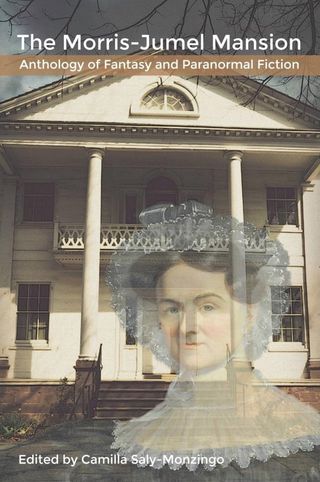Fantasies
New York’s Most Haunted Mansion
A new anthology introduces the intriguing Morris-Jumel mansion to readers.
Posted January 13, 2018

The oldest house in Manhattan has a unique history, even without the ghosts, but many claim it’s haunted. Today, it’s a museum that offers lectures, exhibits, tours, and even a movie night. There’s also a garden camp during the summer. Lin-Manuel Miranda wrote some scenes from Hamilton here and offered a benefit performance. Recently on display was the work of New Yorker cartoonist Charles Addams, creator of the Addams family.
Built in 1765 by Roger Morris as a summer villa for his family, this house at 65 Jumel Terrace commands such fine views of Manhattan that George Washington used it as his war headquarters in 1776. French merchant Stephen Jumel purchased the place in 1810 and soon brought over his bride, Eliza, who would eventually become sole owner. Her second husband, in a short-lived unhappy marriage, was Aaron Burr, the former vice president who killed Hamilton in a duel. Eliza lived here until she was 90, dying in 1865.
Although the mansion is featured in many tour books, there is now a fiction anthology that brings its many different features alive. Editor Camilla Saly-Monzingo, a writing teacher and activist, is a New Yorker with a deep appreciation for the mansion’s history. She lives downhill from it and even got married on its steps, dressed to honor the 1830s era. At the reception, she reserved a place for the deceased Mme. Jumel, because, as she puts it, “Eliza Jumel’s presence is unmistakable.”
Contributing authors to The Morris-Jumel Mansion Anthology of Fantasy and Paranormal Fiction all have impressive publishing records, and the stories cover a range of literary genres. “What is particularly gratifying about this collection,” says Saly-Monzingo, “is its diversity. The writers are Latino, African-American, white, gay, straight, bisexual. They are parents, they are childfree, they are single and partnered. They are young and hungry; they are settling into mid-life; they are older and wiser. What’s more, these tales include ghost stories, science fiction, mystery, romance, erotica, time travel, visions of the afterlife, and paranormal fantasy.”
First, readers get a brief history of the mansion, which nicely frames the tales, and some authors deepen these facts. “How Eliza Became a Ghost,” by Andrea James, for example, takes you on a virtual tour of the mansion-turned-museum, but others emphasize the woman’s background and personality. A maid tells one story, while another tale offers a caretaker’s concerns. There’s even a story for Hamilton fans and a radioplay spurred by school kids spotting “the ghost.” Although several ghosts reportedly haunted the place, the one most people claim to have seen is the specter of Eliza Jumel-Burr.
While Stephen Jumel was on an extended stay in France, Eliza kept busy with real estate ventures. As he was losing his fortune, she was gaining her own. She made sure that one of those gains was the Morris-Jumel mansion. Stephen died mysteriously in 1832, and just over a year later, Eliza married Aaron Burr. She was seeking status, and he was seeking money. One thing she was not going to lose, however, was her fortune, so the spendthrift Burr was quickly ousted.
Eventually, Eliza became reclusive, and some say that she could be a frightening sight in her old age, with false teeth, unkempt hair, soiled clothing, and ungainly large feet. In 1865, she died alone in the mansion. Soon, people were claiming to have seen her on the premises, clad in a white dress.
According to a famous ghost investigator, Hans Holzer, there was suspicion that Eliza had killed her first husband, Stephen, so he took a psychic with him to explore the mansion. The psychic reportedly channeled Stephen’s spirit and heard him say that he had indeed been murdered—and buried alive!
The true star of this anthology, however, is the multifaceted Eliza, with the mansion as a projection of her larger-than-life presence—alive or dead. That she was a grand woman with an imposing personality is apparent in these stories. Readers of paranormal tales, as well as lovers of history and of New York settings, will enjoy this collection.
References
Saly-Monzingo, C. (2017). The Morris-Jumel Mansion Anthology of fantasy and paranormal fiction. Riverdale, NY: Riverdale Avenue Books.


